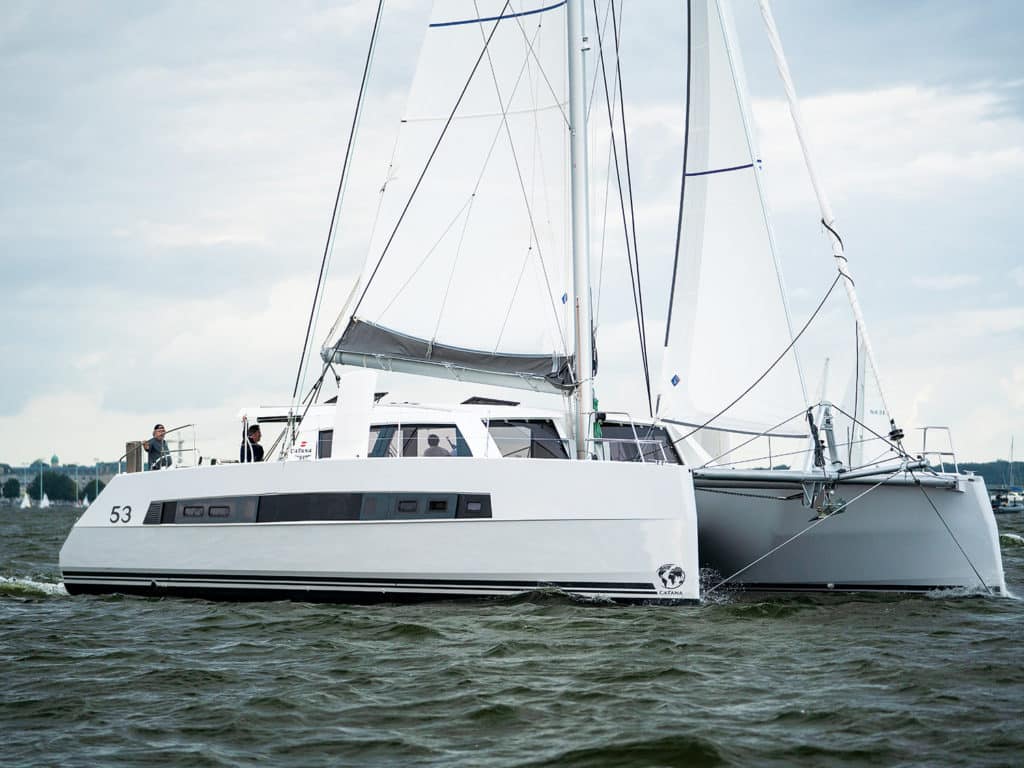
The Catana 53, which CW‘s Boat of the Year judges and I took for a spin last fall following the U.S. Sailboat Show in Annapolis, Maryland, is a boat that gets you thinking: Why are we short-tacking across the brown waters of the Chesapeake, when instead we could be dancing across tropical blue rollers and riding steady trade winds, with the boat delivering on its design promise of endless and effortless 200-plus-mile days?
Good question.
For the purpose of our test sail, the Catana did just fine. Flying the self-tending jib, we tacked upwind at 7.9 knots in 15 knots of breeze. And with the solent rig’s screecher rolled out and the main eased, the speedo jumped to 10 knots or so on a beam reach. Still, as BOTY judge Tim Murphy later declared to his mates, “If you think about a couple who is going to cruise long distances, I can imagine sitting at the nav station, down low, looking under the headsail, in the warm sheltered saloon, making really nice miles and arriving rested.”
Amen to that. In fact the judging team took little time before naming the French-built boat Best Cruising Multihull Over 50 Feet.
From bow to stern, there’s a lot to like about the Catana as a passagemaker. In good weather, the helmsman can sit outdoors at either of the helm stations, on fold-down seats positioned outboard and close to the transom of each hull. Visibility through and across the boat is excellent, thanks to the large windows encircling the saloon; telltales on the sails are in plain view; and from either perch, it’s easy to converse with a mate or guests in the cockpit. If, on the other hand, things turn squally, the on-watch crew can head inside, close four sliding glass doors to button up the saloon, kick on the AC or fire up the Webasto heating system, and settle in at the forward-facing nav station and steer by autopilot.
Electric winches are adjacent to each wheel, and all lines lead aft to them. The mainsail is controlled by a double-ended sheet that forms a bridle across the transom. The blocks on either side of the V are anchored to padeyes using soft shackles, and can be moved easily farther outboard for better sail shape when reaching and running. The boom itself is relatively low above the cabin top and Bimini, and the gooseneck and sail pouch are quite reachable.
Catana uses foam coring and vinylester resin when infusing its hulls, decks and bulkheads, adding in carbon fiber and Twaron cloth to the fiberglass where needed for strength or stiffness. Compared to more mainstream cats, which commonly have displacement-length ratios approaching 180, the Catana weighs in at 97, an indicator—along with twin dagger boards—that performance plays a factor in the design brief. Murphy noted that such weight saving comes at a price. The boat we sailed goes for $1.35 million, or about $400,000 to $500,000 more than you might spend on a cruising rival—but still, that’s considerably less than the all-carbon rocket ships available nowadays.
Catana doesn’t build a charter specific version, but there are choices. The boat we took for a ride was an Owner’s version. The cockpit features a table to port that seats six. A daybed sits opposite and a couch spans the transom. A second table, just inside on the portside of the saloon, continues the dining arrangements. The aforementioned nav desk is located far forward, past the companionway leading to guest quarters in the port hull.
A galley, equipped and stocked for a chef, includes counter space that stretches out in a large U and takes up the entire starboard side of the saloon. The space is broken up nicely by a large island with more countertop.
Below to port, there are two single bunks in the aft cabin and a double berth forward. Each cabin has an en suite shower and they share a head. The starboard hull holds the owner’s palace, with an island queen berth aft, drawers amidships, and a head and separate shower forward. An optional crew cabin can be installed in a large locker in the forepeak or the area can be used for storage, as it is in the other hull.
The 53 comes in a Family layout, as well, with a fourth double cabin forward in thestarboard hull and a shared head.
With either layout, owners will have a sturdy platform for pursuing big dreams, and better yet, they’ll get where they’re going quickly.
Mark Pillsbury is CW‘s editor.








